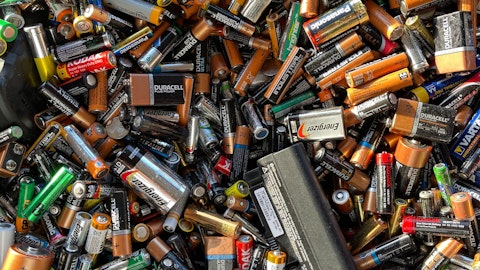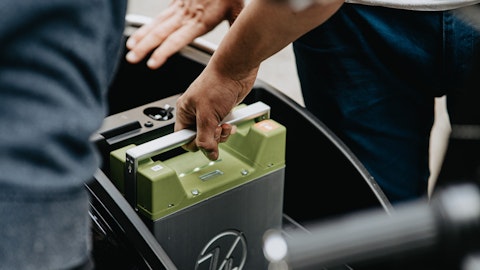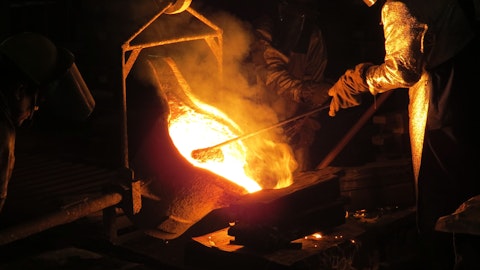Gerardo Illanes: So, as soon as we already finished our expansion, now we are focusing obviously on reducing our costs, increasing the yield. I don’t know if you know, but we have been reducing our brine extraction according to our sustainability plan defined in November 2020, so that means we have less brine and will have there for the other side, the challenge to keep producing more. So, that is a huge challenge. But at the same time, we have been increasing the yield in our chemical plant, so that will mean less cost in the coming year, but we still need to analyze that in the coming months for the – when we made the budget for next year.
Lucas Ferreira: Perfect. Thank you very much.
Operator: The next question comes from Ben Isaacson with Scotiabank. Please go ahead.
Ben Isaacson: Thank you very much. Two questions. One on the market in general, we see that the futures market is showing $16,000 or $17,000 per ton. Can you reflect on that price level, how liquid do you think that market is? Who is actually selling at those prices? And are you concerned that prices will stay in that area for all of 2024? And my second question is the Salar Futuro program that you announced a couple of years ago, how is the DLE tracking? When can we expect the first tons to come out from DLE? And how will that change your cost profile? Thank you.
Felipe Smith: Hello Ben, this is Felipe Smith. How are you? Let me comment a little bit about the market, first of all. So well, the demand fundamentals remain solid in the long-term. We are convinced about that, with an annual average growth above 20% for the next 5 years, okay. We expect EV sales of around 14 million units this year, which represents still a growth of around 45% compared to last year. So, that is a first as an introduction. Now, we have seen some softening of the demand outside China, which coupled with higher than expected supply has resulted in some excess of inventories accumulated in the whole battery supply chain. And this is what is resulting in prices showing downward pressure today, okay. So, what will happen in the future, well, it’s difficult.
Prices are at the end, the result of supply and demand. But as part of our commercial strategy, we will continue to be contracting volumes following market indices. During 2023, we have been able to strengthen further the relationship with our customers. We have entered into several new long-term supply agreements. And that at the end – and those long-term agreements also are based on these indices. So basically, SQM will always follow whatever the market is. And we are very confident on the fact that we are a cost leader. So, our leadership position in cost, quality and sustainability, allow us to be very confident that we will always be there in the market.
Ricardo Ramos: Sorry, about DLE, and as you know, we have been working, as I already explained a couple of minutes ago, we are now working in what is going to be the technology and process and everything about Salar Futuro. And of course, if we will reach – if we would reach an agreement with Codelco, and we have a project together with them, of course we will be very clear and very specific about all the technologies and that – and process we expect to implement in the Salar de Atacama. And of course, one of the alternatives, we have many different technical alternatives, technological alternatives with DLE, but so far, we will announce if we have something for clear. But anyway, we have been advancing in the technology point of view in order to have a new technology available to SQM. I will ask Mark, if you can comment what we have been doing in terms of M&A in order to have more DLE knowledge experience.
Mark Fones: Thanks Ricardo. So, yes, as you mentioned, we continue to be active in M&A, not only in the resource base, but also in further downstream technologies, both in processing and also in – starting from DLE technologies. So, in the last quarter, so Q3 of this year, we have made an investment to acquire a percentage stake on a French company called Adionics. And this is a French developer on DLE technology. And we are looking forward to continue now working together with them in engineering and developing industrial scaling for this kind of technology into the future. This is in addition also to other ventures and innovations and investments we perform in the SQM Lithium ventures that we also tackle entrepreneurship and innovation in that area.
Ben Isaacson: Great. Thank you very much.
Operator: The next question comes from Isabella Simonato with Bank of America. Please go ahead.
Isabella Simonato: Thank you. Good afternoon everyone. My question is on SPN. I think it’s interesting that you guys are calling for the bottom on prices, right? When we look at the potash prices you guys had in the quarter and the spot prices for potash right. It seems that there is downside to potash from now on. But on the other hand, as you are expecting more flattish SPN or some recovery on prices from now on, can we assume that the premium widened from Q3 levels going forward? I mean if you could give us a little bit more color on how are you seeing the dynamics of prices between one and another, I think it could be helpful? Thank you.




